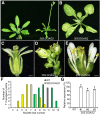Characterization of C- and D-Class MADS-Box Genes in Orchids
- PMID: 32900977
- PMCID: PMC7608164
- DOI: 10.1104/pp.20.00487
Characterization of C- and D-Class MADS-Box Genes in Orchids
Abstract
Orchids (members of the Orchidaceae family) possess unique flower morphology and adaptive reproduction strategies. Although the mechanisms underlying their perianth development have been intensively studied, the molecular basis of reproductive organ development in orchids remains largely unknown. Here, we report the identification and functional characterization of two AGAMOUS (AG)-like MADS-box genes, Dendrobium 'Orchid' AG1 (DOAG1) and DOAG2, which are putative C- and D-class genes, respectively, from the orchid Dendrobium 'Chao Praya Smile'. Both DOAG1 and DOAG2 are highly expressed in the reproductive organ, known as the column, compared to perianth organs, while DOAG2 expression gradually increases in pace with pollination-induced ovule development and is localized in ovule primordia. Ectopic expression of DOAG1, but not DOAG2, rescues floral defects in the Arabidopsis (Arabidopsis thaliana) ag-4 mutant, including reiteration of stamenoid perianth organs in inner whorls and complete loss of carpels. Downregulation of DOAG1 and DOAG2 in orchids by artificial microRNA interference using l-Met sulfoximine selection-based gene transformation systems shows that both genes are essential for specifying reproductive organ identity, yet they, exert different roles in mediating floral meristem determinacy and ovule development, respectively, in Dendrobium spp. orchids. Notably, knockdown of DOAG1 and DOAG2 also affects perianth organ development in orchids. Our findings suggest that DOAG1 and DOAG2 not only act as evolutionarily conserved C- and D-class genes, respectively, in determining reproductive organ identity, but also play hitherto unknown roles in mediating perianth organ development in orchids.
© 2020 American Society of Plant Biologists. All Rights Reserved.
Figures








Similar articles
-
Overexpression of DOSOC1, an ortholog of Arabidopsis SOC1, promotes flowering in the orchid Dendrobium Chao Parya Smile.Plant Cell Physiol. 2013 Apr;54(4):595-608. doi: 10.1093/pcp/pct026. Epub 2013 Feb 8. Plant Cell Physiol. 2013. PMID: 23396600
-
DOTFL1 affects the floral transition in orchid Dendrobium Chao Praya Smile.Plant Physiol. 2021 Aug 3;186(4):2021-2036. doi: 10.1093/plphys/kiab200. Plant Physiol. 2021. PMID: 33930147 Free PMC article.
-
DOAP1 Promotes Flowering in the Orchid Dendrobium Chao Praya Smile.Front Plant Sci. 2017 Mar 23;8:400. doi: 10.3389/fpls.2017.00400. eCollection 2017. Front Plant Sci. 2017. PMID: 28386268 Free PMC article.
-
The orchid MADS-box genes controlling floral morphogenesis.ScientificWorldJournal. 2006 Jul 14;6:1933-44. doi: 10.1100/tsw.2006.321. ScientificWorldJournal. 2006. PMID: 17205198 Free PMC article. Review.
-
MADS reloaded: evolution of the AGAMOUS subfamily genes.New Phytol. 2014 Feb;201(3):717-732. doi: 10.1111/nph.12555. Epub 2013 Oct 25. New Phytol. 2014. PMID: 24164649 Review.
Cited by
-
Advances and prospects of orchid research and industrialization.Hortic Res. 2022 Sep 28;9:uhac220. doi: 10.1093/hr/uhac220. eCollection 2022. Hortic Res. 2022. PMID: 36479582 Free PMC article.
-
Characterization of Two AGAMOUS-like Genes and Their Promoters from the Cymbidium faberi (Orchidaceae).Plants (Basel). 2023 Jul 24;12(14):2740. doi: 10.3390/plants12142740. Plants (Basel). 2023. PMID: 37514354 Free PMC article.
-
Unveiling the molecular mechanism of sepal curvature in Dendrobium Section Spatulata through full-length transcriptome and RNA-seq analysis.Front Plant Sci. 2024 Dec 13;15:1497230. doi: 10.3389/fpls.2024.1497230. eCollection 2024. Front Plant Sci. 2024. PMID: 39735769 Free PMC article.
-
PeNAC67-PeKAN2-PeSCL23 and B-class MADS-box transcription factors synergistically regulate the specialization process from petal to lip in Phalaenopsis equestris.Mol Hortic. 2024 Apr 23;4(1):15. doi: 10.1186/s43897-023-00079-8. Mol Hortic. 2024. PMID: 38649966 Free PMC article.
-
Comparative Transcriptomic and Metabolic Analyses Reveal the Molecular Mechanism of Ovule Development in the Orchid, Cymbidium sinense.Front Plant Sci. 2022 Jan 21;12:814275. doi: 10.3389/fpls.2021.814275. eCollection 2021. Front Plant Sci. 2022. PMID: 35126436 Free PMC article.
References
-
- Carlson JE, Tulsieram LK, Glaubitz JC, Luk VWK, Kauffeldt C, Rutledge R(1991) Segregation of random amplified DNA markers in F1 progeny of conifers. Theor Appl Genet 83: 194–200 - PubMed
-
- Chai D, Lee SM, Ng JH, Yu H(2007) L-methionine sulfoximine as a novel selection agent for genetic transformation of orchids. J Biotechnol 131: 466–472 - PubMed
Publication types
MeSH terms
Substances
LinkOut - more resources
Full Text Sources
Miscellaneous

